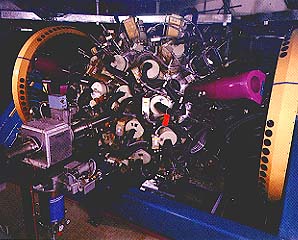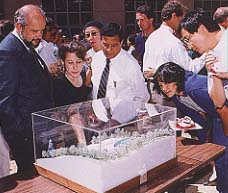




| 
| 
| 
|

| The Gammashpere detector, the world's most powerful instrument for detecting gamma rays, was dedicated at the Berkeley Lab, where it was designed and built, on December 1, 1995. |
 Dedicated on December 1, 1995, Gammasphere has been a rich resource for
scientists in nuclear physics both nationally and internationally, providing
nearly two hundred researchers from institutions around the world with insight
into the unseen, enigmatic interactions that take place inside the atomic
nucleus. Likewise, the Human Genome Laboratory, begun in 1995 and expected to be
completed in 1997, promises to be a vital resource in the national effort to
decipher the human genetic code. Information generated at Berkeley Lab's Human
Genome Center has already contributed to the development of improved methods of
screening genetic abnormalities, locating cancer genes, and diagnosing solid
tumors.
Dedicated on December 1, 1995, Gammasphere has been a rich resource for
scientists in nuclear physics both nationally and internationally, providing
nearly two hundred researchers from institutions around the world with insight
into the unseen, enigmatic interactions that take place inside the atomic
nucleus. Likewise, the Human Genome Laboratory, begun in 1995 and expected to be
completed in 1997, promises to be a vital resource in the national effort to
decipher the human genetic code. Information generated at Berkeley Lab's Human
Genome Center has already contributed to the development of improved methods of
screening genetic abnormalities, locating cancer genes, and diagnosing solid
tumors.
 Along with such research programs, one of the roles of a national laboratory
is to maintain unique research facilities for use by any qualified scientist in
the country. These national user facilities are another measure of a host
institute's value to the country. Berkeley Lab is home to five national user
facilities, including two of the country's newest: the Advanced Light Source
(ALS) and the High-Performance Computing Access Center (HPC).
Along with such research programs, one of the roles of a national laboratory
is to maintain unique research facilities for use by any qualified scientist in
the country. These national user facilities are another measure of a host
institute's value to the country. Berkeley Lab is home to five national user
facilities, including two of the country's newest: the Advanced Light Source
(ALS) and the High-Performance Computing Access Center (HPC).
 The ALS is an electron accelerator and storage ring that can generate beams
of x-ray and ultraviolet light at wavelengths and energies ideal for a wide
variety of purposes. Researchers working to develop new materials can use ALS
x-rays as spectroscopic probes to focus on surface areas only a few hundred atoms
in diameter. Chemists can use its strobe-like pulses of light to produce
billionth-of-a-second snapshot images of chemical reactions. Biologists are using
the ALS as an x-ray microscope to look inside living cells, and expect to soon be able to
produce the first holograms of internal cell structures. Earth scientists are
using ALS beams to scrutinize environmental contaminants on a scale never before
possible.
The ALS is an electron accelerator and storage ring that can generate beams
of x-ray and ultraviolet light at wavelengths and energies ideal for a wide
variety of purposes. Researchers working to develop new materials can use ALS
x-rays as spectroscopic probes to focus on surface areas only a few hundred atoms
in diameter. Chemists can use its strobe-like pulses of light to produce
billionth-of-a-second snapshot images of chemical reactions. Biologists are using
the ALS as an x-ray microscope to look inside living cells, and expect to soon be able to
produce the first holograms of internal cell structures. Earth scientists are
using ALS beams to scrutinize environmental contaminants on a scale never before
possible.
 In addition to basic science, the ALS is also serving the technology
industry. Industrial researchers from IBM have built their own beamline to help
them develop new techniques for manufacturing computer chips. Other industrial
researchers are collaborating with Berkeley Lab scientists on the development of
nano- technology, a technology that entails electronic devices with features a
thousand times smaller than the microcircuits of today. The microtechnology
industry has grown to an annual market worth more than $100 billion, but experts
believe that the pending nanotechnology market will dwarf this figure. A facility
such as the ALS can provide the United States with a big edge.
In addition to basic science, the ALS is also serving the technology
industry. Industrial researchers from IBM have built their own beamline to help
them develop new techniques for manufacturing computer chips. Other industrial
researchers are collaborating with Berkeley Lab scientists on the development of
nano- technology, a technology that entails electronic devices with features a
thousand times smaller than the microcircuits of today. The microtechnology
industry has grown to an annual market worth more than $100 billion, but experts
believe that the pending nanotechnology market will dwarf this figure. A facility
such as the ALS can provide the United States with a big edge.
 Computing capabilities promise another big edge, both for basic scientific
research and for the development of new commercial technologies. The HPC, which
is now in the process of being assembled at Berkeley Lab, will provide academic
and industrial researchers in the United States with access to supercomputers and
a high-speed information-sharing network that connects thousands of computers all
over the world. These capabilities will enable scientists to conduct
computational experiments in all fields of science, from the esoteric intricacies
of quantum chromodynamics to the complex vicissitudes of global climate change.
Computing capabilities promise another big edge, both for basic scientific
research and for the development of new commercial technologies. The HPC, which
is now in the process of being assembled at Berkeley Lab, will provide academic
and industrial researchers in the United States with access to supercomputers and
a high-speed information-sharing network that connects thousands of computers all
over the world. These capabilities will enable scientists to conduct
computational experiments in all fields of science, from the esoteric intricacies
of quantum chromodynamics to the complex vicissitudes of global climate change.
 The two major components of HPC are the National Energy Research
Supercomputing Center (NERSC) and the Energy Sciences Network (ESnet). NERSC will
be host to a nest of Cray supercomputers, starting with a Cray C-90 that boasts
16 central processing units with a peak speed of one billion arithmetic
operations per second, and augmented with five more Crays. ESnet is a high-speed
network that provides computers across the land with virtually instant access to
the capabilities of NERSC. ESnet can move information at speeds up to 155 million
bits per second. Compare this to the 28,000 bits per second transmission speed of
today's fastest phone modems, and it is easy to understand why scientists and
engineers throughout the nation will benefit from the HPC.
The two major components of HPC are the National Energy Research
Supercomputing Center (NERSC) and the Energy Sciences Network (ESnet). NERSC will
be host to a nest of Cray supercomputers, starting with a Cray C-90 that boasts
16 central processing units with a peak speed of one billion arithmetic
operations per second, and augmented with five more Crays. ESnet is a high-speed
network that provides computers across the land with virtually instant access to
the capabilities of NERSC. ESnet can move information at speeds up to 155 million
bits per second. Compare this to the 28,000 bits per second transmission speed of
today's fastest phone modems, and it is easy to understand why scientists and
engineers throughout the nation will benefit from the HPC.
 The other national user facilities at Berkeley Lab are the National Center
for Electron Microscopy, housing the country's most powerful electron
microscopes; the National Tritium Labeling Facility, the only government facility
in the U.S. where tritium-labeled compounds for biomedical studies are prepared;
and the 88-Inch Cyclotron, the nation's most productive low- energy nuclear
physics accelerator. Many other state-of-the-art facilities, equipment, and
instruments at Berkeley Lab, though not bearing the "national" designation, are
also made available for use by researchers nationwide.
The other national user facilities at Berkeley Lab are the National Center
for Electron Microscopy, housing the country's most powerful electron
microscopes; the National Tritium Labeling Facility, the only government facility
in the U.S. where tritium-labeled compounds for biomedical studies are prepared;
and the 88-Inch Cyclotron, the nation's most productive low- energy nuclear
physics accelerator. Many other state-of-the-art facilities, equipment, and
instruments at Berkeley Lab, though not bearing the "national" designation, are
also made available for use by researchers nationwide.

| From left, Deputy Director Pier Oddone and Life Sciences researchers Judy Campisi and Aloke Chatterjee are among the celebrants studying the architect's model of the new Human Genome Laboratory at the groundbreaking ceremony held August 15, 1995. |
 But above and beyond personnel and equipment, what makes Berkeley Lab truly
national is the scientific knowledge acquired here-in physics and life sciences,
materials, chemistry, energy, and the environment. As can be seen in the pages
that follow, this knowledge benefits everyone in the nation.
But above and beyond personnel and equipment, what makes Berkeley Lab truly
national is the scientific knowledge acquired here-in physics and life sciences,
materials, chemistry, energy, and the environment. As can be seen in the pages
that follow, this knowledge benefits everyone in the nation.

| 
| 
|